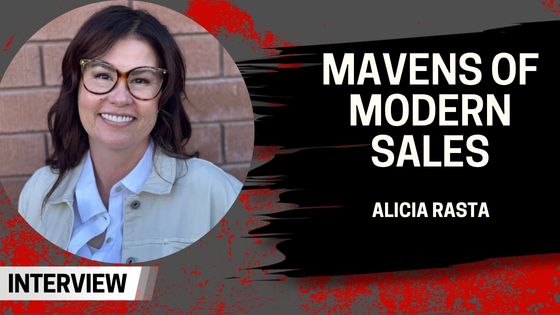Mavens of Modern Sales – Alicia Rasta
Previously Published on A Sales Growth Company
Welcome to Mavens of Modern Sales, where we take a deep dive with the sales leaders pulling sales teams in the 21st century to get their insights on leadership, strategy, industry trends, and more.
This week we talked to Alicia Rasta, Vice President and Head of Global Sales at Televerde.
You mentioned in a recent post that confidence can take you many places in life. Can you share a specific example or story from your life/career where confidence played a role in moving you forward?
There are so many examples, but one completely changed my trajectory. I was attending a scoping call with a customer for a project that was new to our product line offerings. My boss at the time, “Bob,” told me, “Your job tomorrow is to sit in the corner and take notes.” That hit hard. I responded, telling him how demoralizing it was to hear that (but in stronger terms). His response was, “Let the experts handle the hard stuff.”
In the meeting, I waited for Bob to take charge, but he sat there doodling. So, I started asking the customer a series of questions—deep, drill-down questions to uncover the root cause of their request. Bob didn’t jump in, so I kept going. By the end, they asked for a formal proposal. I handed it to Bob to see if he had anything to add, and he simply said, “Nope, you covered it all.”
In the taxi afterward, Bob admitted, “I guess you really do know how to do your job. Now the only question I have is how do I impart my 20+ years’ experience into your brain?” Despite the rough start to this story, I still regard Bob as the best salesperson I have ever met, and this experience was pivotal in proving I belonged in the room, not on the sidelines.
A while back you mentioned holding an NFL Draft style event for account selection. We are dying to hear more about this and how this has played out some 10 months later.
We had field sellers holding onto accounts for years without making progress. To shake things up, I introduced the NFL Draft concept. We reviewed prospect accounts with recent activity—those stayed with their owners. The rest were up for grabs. Each AE had 30 seconds to pick from the available accounts, one person at a time, just like in an NFL Draft.
The team was nervous at first, worried about losing accounts or hurting feelings. But during the draft, everyone had a blast. It brought fresh energy to stagnant accounts, held the team accountable, and gave them freedom to choose. They’re already excited for our next draft in 2025!
You’ve said that throughout your sales career you’ve been trained on numerous sales methods. At what point did you experience the shift, realizing that the buyer’s context should be the focal point of a sales approach?
Televerde has always followed SPIN, and as BANT lost relevance, we adjusted. Early in my career, I moved into Client Success, where I focused on understanding customers’ needs and offering solutions. That led to my shift into sales. The sales leader at the time noticed that I kept letting his team know they needed to write contracts and he had the bright idea to bring me into the sales org.
At first, I resisted, fearing I’d end up prioritizing quotas over customers. I really didn’t want my customer-centric approach to change because I was tied to a quota. But our CEO told me that if I focus on my customers’ needs, I will never have to worry about my quota. I’ve carried that mindset ever since and instilled it in my team. No one likes the stereotypical salesperson!
From your unique point of view, in the past decade, how have you observed the change in buyers and buying behavior during the sales process?
It’s night and day. A decade ago, the phone was the main tool, and email was secondary. There were fewer people involved in the decision process, and sales cycles were longer but more straightforward. Conversions from first touch throughout the funnel were higher than many companies see today, despite the longer cycle.
Today, with the rise of digital information, buyers do much of their own research. They’re bombarded with outreach, so they’re tuning out. Ironically, with all this automation, people now crave human connection, making the phone valuable again. People don’t have the time to spend on tools that aren’t a priority. There is a lot of value in a seller’s ability to dig into what a prospect truly needs, and they must provide clear value, positioning themselves as trusted partners, not just product providers. What’s more, the days of only having one champion within an organization are over. Sellers need to understand the entire buying group and what each individual cares about or what their major concerns are to be successful.
Given your unique journey at Televerde, what strategies do you implement to maintain motivation and drive within your global sales team, especially in challenging markets/conditions?
Our model is unique—we work with departments of corrections to provide opportunities to women, training them as SDRs and helping them to become top performers. Many go on to work for us or our clients, transforming their lives—buying a house, a car, and putting themselves on a track that is very different than the one that landed them in the DOC in the first place.
So, motivation comes from tracking how many opportunities we create for these women. How many of our clients have hired from our offices? How has their work changed lives and created opportunities for more women? This makes motivation self-sustaining.
At the 2023 Women of The Channel Leadership Summit East, you were featured as a Keynote speaker. You mentioned that one of your mentors emphasized the environment Televerde created for your growth. How do you ensure your global sales team has access to the same environment that fostered your development?
Televerde’s culture is built around providing opportunities for growth. However, the environment has changed a lot since I started 14 years ago!
One of our core values as a company is fostering a passion for learning. Because of that, we offer advanced training and certifications (like Salesforce and Python), we run book clubs across the field sales, CX, and internal demand generation teams, and we provide access to learning platforms and external events for the team to expand their knowledge and build new skills. Ultimately, as I mentioned during the event, the resources are there, but it’s up to each individual to take advantage of them.
Given the rapid advancements in AI for SDR roles, how do you see AI fitting in with or potentially replacing the traditional SDR model, and what do you think will be the impact on buyer adoption as technology continues to evolve?
AI has been an amazing tool to help educate folks and speed up research on organizations and contacts. We can accomplish things in 15 minutes that used to take hours of prep time.
However, the most recent play we’re seeing in the market is digital, AI-driven SDR programs, where companies are using AI technology to handle mass, semi-customized digital outreach to drive leads to sales teams. There has been a lot of excitement around this as a low-cost solution for top of funnel, which it is. But what we’re seeing now is that many sales teams are getting jaded with the quality of the meetings. At the end of the day, people buy from people and AI is not a replacement for human interaction. Human-to-human connection is a necessity in today’s environment and will only become more important as time goes on.


